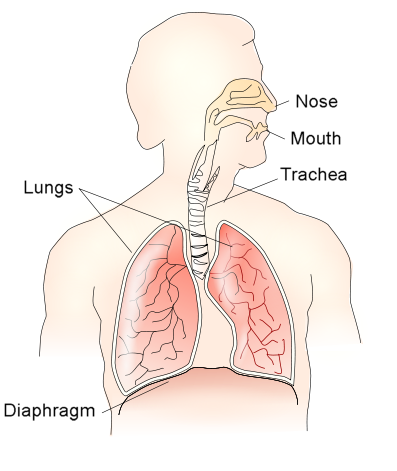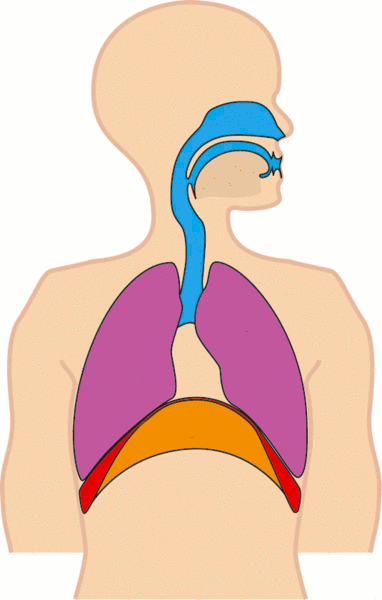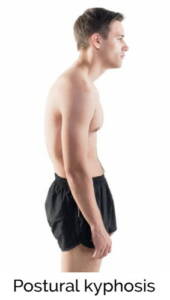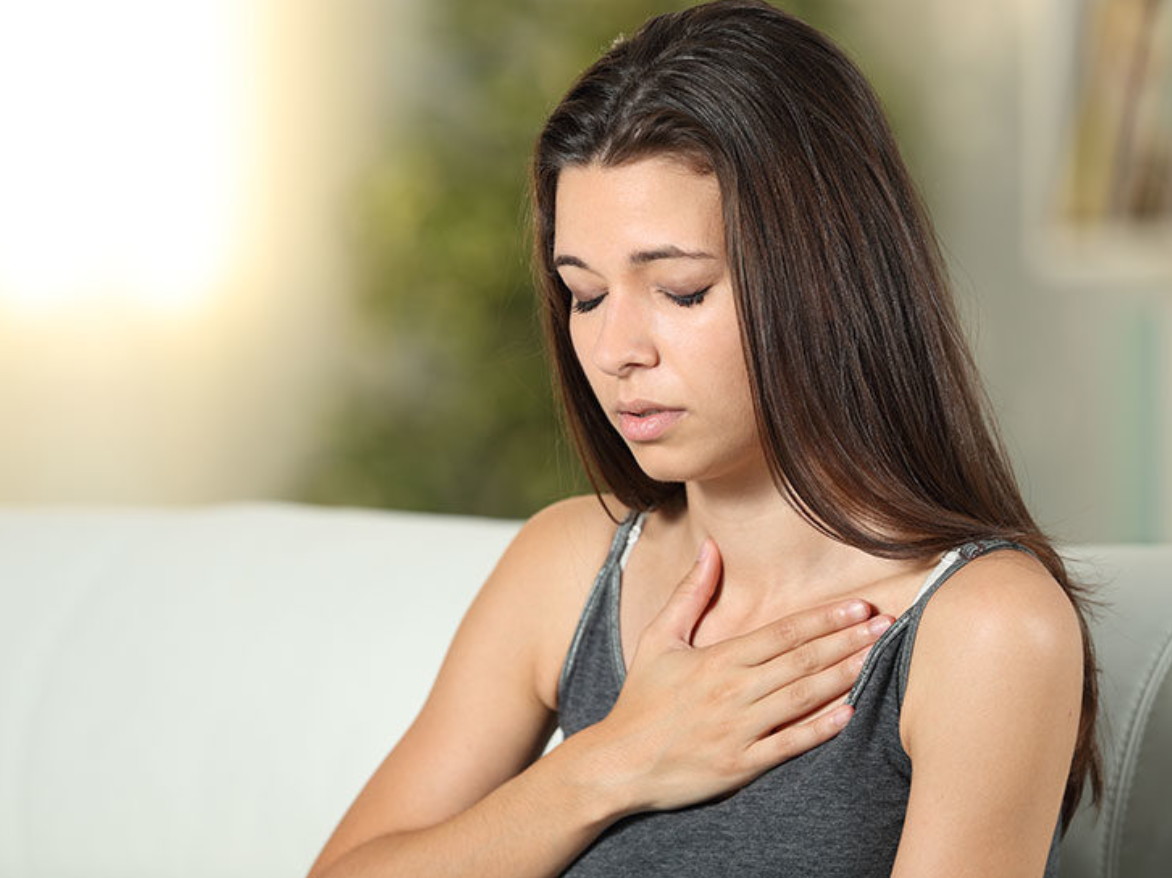Cómo aliviar la respiración superficial
El estrés crónico, la postura y la tensión muscular pueden influir en el desarrollo de una respiración superficial, también denominada respiración torácica o torácica. La respiración superficial puede contribuir a afecciones médicas graves como trastornos de ansiedad, ataques de pánico, hiperventilación, shock, asma, neumonía, edema pulmonar y una acumulación de dióxido de carbono en el cuerpo conocida como hipercapnia.
Para la mayoría de nosotros, la forma en que respiramos es habitual, lo que significa que no somos conscientes de ello. Es fácil pasarse la vida respirando superficialmente, aumentando su nivel de estrés y poniéndose en riesgo de sufrir problemas de salud, sin ser consciente de ello. Por lo tanto, es importante sintonizar con su respiración y dedicar tiempo a entrenarse para respirar diafragmáticamente.
En esta publicación, analizo:
- Tipos de respiracion
- Por qué el estrés crónico provoca una respiración superficial
- Cómo la postura y la tensión muscular provocan una respiración superficial
- Los músculos involucrados en la respiración.
- Los nervios involucrados en la respiración.
- Respiración nasal frente a respiración bucal
- Aprender a respirar diafragmáticamente
- Somática Clínica ejercicios que alivian la respiración superficial
Tipos de respiración: diafragmática, superficial, clavicular y eupnea.
As you can see in the diagrams below, the diaphragm is an umbrella-shaped muscle located just below our lungs. In Respiración diafragmática, we contract our diaphragm, pulling its center downward and inverting its umbrella shape as we inhale. This action draws air into our lungs, and pushes the contents of our belly forward. So, our abdominal muscles must be able to fully relax in order to allow us to take a full inhale and let our belly expand forward. Then as we release our diaphragm, it relaxes upward and expels the air out of our lungs.


When we become stressed for any reason, however, we instinctively shift to Respiracion superficial. This is also referred to as chest breathing and thoracic breathing. This type of breathing consists of drawing air into the lungs without allowing the belly to expand forward. Shallow breathing mainly uses the intercostal muscles (the muscles in between the ribs) instead of the diaphragm. Shallow breathing, as the term implies, does not allow us to take full breaths.
Clavicular breathing involves drawing air into the chest by raising the shoulders and collarbone (clavicle). To do this, we simultaneously contract the abdominal muscles. This type of breathing results in the least amount of air being inhaled.
If you are at rest and you have nothing limiting your ability to take a full breath—stress, muscle tension, or posture—then you will likely notice that your breathing is in the state of eupnea. This is also called quiet breathing, and it requires no conscious effort.
Eupnea is the healthy, unaffected breathing of all mammals. In the state of eupnea, the diaphragm and external intercostal muscles automatically contract to draw air into the lungs. The abdominal muscles are relaxed, allowing the belly to gently expand forward during inhalation. The chest also expands during inhalation, and the collarbone and shoulders will subtly rise. During exhalation, the belly, chest, collarbone, and shoulders all return to their neutral resting position.
Por qué el estrés crónico provoca una respiración superficial
Cuando percibimos una amenaza a nuestro bienestar, se activa nuestra respuesta de “luchar, huir o congelarnos”. El sistema nervioso autónomo acelera automáticamente nuestra frecuencia respiratoria para que podamos absorber más oxígeno, lo que nos permite defendernos mejor y sobrevivir a los ataques.
La evolución diseñó la respiración superficial para que fuera una solución a corto plazo, no un estado crónico. Pero si experimentamos estrés con regularidad, la respiración superficial puede volverse habitual fácilmente. Eso significa que nuestro sistema nervioso ha adoptado esta forma de respirar como una actividad constante y probablemente no somos conscientes de ello. Si la respiración superficial se vuelve habitual, entonces respiramos de esa manera todo el tiempo, estemos experimentando estrés o no.
Once shallow breathing has become habitual, the breathing pattern itself can induce stress, independent of whether or not we perceive stress in our daily life. Try it: Breathe only up into your chest, not letting your belly expand, and notice how you feel. Do you feel stressed out, simply by breathing this way?
Una fuente específica de estrés que afecta directamente a nuestra respiración es la imagen corporal. Si no queremos parecer obesos, podemos desarrollar el hábito de contraer los músculos abdominales para succionar el estómago. Muchas personas mantienen una tensión crónica en sus abdominales como resultado de succionar el estómago con tanta frecuencia, y esta tensión limita su capacidad de realizar una respiración diafragmática completa.
For suggestions on how to reduce stress, go to The Life-Changing Link Between Anxiety and Muscle Tension and scroll down to the section titled “How to recover from anxiety.”
Cómo la postura y la tensión muscular provocan una respiración superficial
The posture most often associated with shallow breathing is Cifosis postural, or rounded posture. When the abdominal muscles and pectoral muscles are chronically tight, the head, shoulders, and rib cage are pulled forward. Try it: Do a “crunch” while you’re sitting and reading this, and you’ll feel how tight abdominal and chest muscles can keep you stuck in rounded posture.
En la cifosis postural, la cavidad torácica está comprimida y los abdominales tensos. Por lo tanto, los pulmones no sólo no pueden expandirse completamente dentro de la cavidad torácica, sino que el abdomen no puede expandirse hacia adelante para permitir que el diafragma presione hacia abajo.
The opposite postural pattern, hyperlordosis, can also cause shallow breathing. When the psoas major is tight, it can pull the lower back into an exaggerated arch (hyperlordosis) as well as create a thrusting forward of the rib cage, which limits the ability to take a full breath. A tight psoas also compresses the lumbar spine, shortening the torso, which limits the space in which the diaphragm can contract downward.
, a lateral (sideways) curvature of the spine, can cause shallow breathing as well. This is most likely to occur if the curve is in the thoracic or thoracic and lumbar parts of the spine, where the lateral curve and associated spinal rotation would directly limit the ability to expand the lungs.



Los músculos involucrados en la respiración.
Below, I’ve listed the muscles involved in breathing. You’ll notice that some of the muscles are only active in “forced” inhalation and exhalation. Forced breathing is typically defined as a process that occurs during exercise in order to take in more oxygen. In forced breathing, accessory muscles are engaged to allow us to breathe more quickly and increase our lung volume.
Músculos de la inhalación y sus acciones:
Diaphragm: Draw the central tendon of the diaphragm downward, increasing the volume of the thoracic cavity. This creates a vacuum in the upper thoracic cavity, pulling air into the lungs.
Scalenes: Elevate ribs during inhalation.
Sternocleidomastoid: Assist in inhalation by elevating the rib cage.
External intercostals: Assist in inhalation by drawing the ribs superiorly (upward), increasing space in the thoracic cavity.
Serratus posterior superior: Elevate ribs during inhalation.
Quadratus lumborum: Fix the last rib.
Pectoralis major: Assist in forced inhalation if arm is fixed.
Pectoralis minor: Assist in elevating the thorax in forced inhalation if scapula is fixed.
Serratus anterior: May assist in forced inhalation if scapula is fixed.
Subclavius: Assist in inhalation by elevating first rib.
Músculos de exhalación y sus acciones:
Internal intercostals: Assist in exhalation by drawing the ribs inferiorly (downward), decreasing space in the thoracic cavity.
Serratus posterior inferior: Depress the ribs during exhalation.
Internal and external obliques: Compress abdominal contents.
Transverse abdominis: Compress abdominal contents.
Quadratus lumborum: Fix the last rib in forced exhalation.
Los nervios implicados en la respiración: vago y frénico.
El sistema nervioso autónomo (la división funcional de nuestro sistema nervioso que controla nuestro cuerpo automáticamente, sin nuestro pensamiento consciente) se divide en sistemas nerviosos simpático y parasimpático. El sistema nervioso simpático está a cargo de la respuesta de “lucha o huida” al estrés cuando percibimos peligro; por lo tanto, automáticamente nos hace respirar superficialmente cuando sentimos estrés.
The parasympathetic nervous system does the opposite: it calms us down, brings our body back into homeostasis, and allows for healing to occur. The vagus nerve is the main neural component of the parasympathetic nervous system. The vagus nerve is the 10th cranial nerve, meaning that it emerges directly from the brain without traveling down the spinal cord. It automatically controls parasympathetic motor functions of the heart, lungs, digestive system, liver, gallbladder, spleen, pancreas, and kidneys. This means that the vagus nerve has the very important job of stimulating the “rest and digest” functions of these organs. The vagus nerve regulates lung function and maintains respiratory balance.
The phrenic nerve originates from the C3-C5 spinal nerves in the neck. It is the only nerve that provides motor control to the diaphragm. The phrenic nerve is not purely autonomic (automatic, subconscious) or somatic (voluntary, conscious), but is a mixed nerve. It carries both automatic and voluntary messages to contract and relax the diaphragm, and provides sensory innervation to the diaphragm and adjacent fascia.
Either or both of these nerves can be compressed by chronic muscle tension in the neck, chest, and abdomen, and misalignment of the cervical or thoracic spine. The function of the vagus nerve is also highly sensitive to stress. So when it comes to the neural regulation of our breathing, we need to be aware of our muscle tension and posture as well as our habitual reactions to stress.
Es un círculo vicioso
Stress, muscle tension, and posture are inextricably linked. Stress causes muscles to tighten and can trigger the withdrawal reflex (rounded posture) or the action response (hyperlordosis). On the flip side, simply having chronic muscle tension increases our stress level. And research shows that adopting certain postures for just two minutes can either raise or lower our stress levels. So, imagine the effects of spending years or decades in a certain posture!
Respiración nasal frente a respiración bucal
Tendemos a respirar por la nariz cuando nos sentimos relajados, y es más probable que respiremos por la boca cuando nos sentimos estresados o cuando hacemos un esfuerzo físico. Pero que respiremos por la nariz o por la boca es técnicamente independiente de la respiración superficial y diafragmática; podemos respirar por la nariz mientras respiramos torácicamente y podemos respirar por la boca mientras respiramos diafragmáticamente. Entonces, ¿debemos preocuparnos por si respiramos por la nariz o por la boca?
We do, argues Patrick McKeown, author of The Oxygen Advantage. When we breathe quietly through our nose, the levels of oxygen and carbon dioxide in our body stay in the correct balance. We need the right amount of carbon dioxide in our body in order to utilize oxygen efficiently. When we overbreathe through our mouths, we exhale too much carbon dioxide, and the balance is thrown off—our body is not able to utilize the oxygen that it has. Nose breathing allows the oxygen in our body to be delivered to our muscles and organs, and improves our physical functioning.
I highly recommend that everyone read The Oxygen Advantage, and it’s especially important if you’re a mouth breather or an endurance athlete. I noticed a significant improvement in my breath control and running performance within just one week of practicing the breathing exercises in this book. People also experience reversal of asthma, snoring, anxiety, and fatigue; regulation of blood sugar, cholesterol, and heart rate; and weight loss.
Aprender a respirar diafragmáticamente
Además de reducir tu estrés y practicar Somática Clínica ejercicios (enumerados a continuación) para liberar los músculos tensos y mejorar su postura, puede practicar la respiración diafragmática. Sólo requiere práctica, como cualquier habilidad muscular. Cuanto más a menudo practique la respiración diafragmática, más habitual se volverá y más relajado se sentirá.
Close your eyes. Completely relax. Visualize your diaphragm inside you, just below your lungs. As you inhale through your nose, visualize the air going down to your lungs, and your diaphragm contracting and pushing downward. Relax your belly muscles, and allow your belly to expand as you inhale. Then slowly exhale, letting your diaphragm relax upward slowly and with control.
Ahora intente esto mientras cuenta lentamente hasta cinco mientras inhala, luego cuente lentamente hasta cinco mientras exhala.
Ahora, cuente lentamente hasta ocho mientras inhala, luego cuente lentamente hasta ocho mientras exhala.
If you’re familiar with pandiculation, you’ll notice that you just pandiculated your diaphragm!
Cuanto más a menudo practiques la respiración diafragmática, más consciente te volverás de cómo respiras. Pronto, notarás cuando respiras superficialmente porque te sentirás mal, e instintivamente te relajarás y volverás al estado respiratorio natural de eupnea.
Somática Clínica ejercicios que alivian la respiración superficial
Some Clinical Somatics exercises are practiced with a specific breathing pattern: you’re instructed to inhale and exhale at certain times. This is instructed in the videos and audios, but if you want further clarification, please read “Breathing in Clinical Somatics Exercises.”
The exercises below allow you to release the tight muscles that contribute to shallow breathing. They are all taught in the online Level One & Two Courses.
Basic daily exercises:
Diaphragmatic breathing (as described in previous section)
Arch & Flatten
Arch & Curl
More advanced:
Side Curl (for breathing affected by scoliosis)
Iliopsoas Release
Proprioceptive Exercise 1
Diagonal Curl
Head Lifts
Scapula Scoops Part 2
Flowering Arch & Curl
Breathing Exercises
Lectura recomendada:
The Pain Relief Secret: How to Retrain Your Nervous System, Heal Your Body, and Overcome Chronic Pain by Sarah Warren, CSE
Somatics: Reawakening the Mind’s Control of Movement, Flexibility and Health by Thomas Hanna

